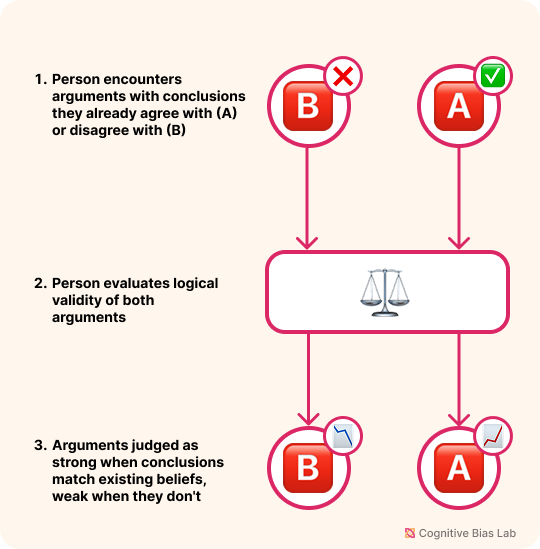Belief Bias
Your progress on this bias test won't be saved after you close your browser.
Understanding Belief Bias
Belief Bias
We're wired to judge arguments based on how well they align with our existing beliefs, not by their actual logical merit. This mental shortcut can blind us to valid evidence that challenges our worldview.
What is Belief Bias?
Belief bias occurs when we evaluate the strength of arguments based on whether their conclusions align with our pre-existing beliefs, rather than on the logical structure and evidence supporting them.
Why Does This Happen?
Key Points:
- Our brains naturally seek cognitive consistency between new information and existing beliefs
- We experience psychological discomfort when faced with evidence that contradicts our worldview
- This bias operates largely outside conscious awareness, making it particularly difficult to detect in ourselves
Real-World Impact
Belief bias can significantly distort decision-making in critical areas:
- Professional Contexts: Executives might reject sound business strategies simply because they contradict industry orthodoxy
- Personal Life: People often dismiss health advice that challenges their lifestyle preferences
- Social Discourse: Political discussions frequently deteriorate when participants evaluate arguments based on alignment rather than merit
Why It Matters
This bias fundamentally undermines critical thinking by allowing subjective beliefs to override objective reasoning. In complex decision environments, belief bias can lead to persistent errors, missed opportunities, and a dangerous resistance to adapting when circumstances change.

Visual representation of Belief Bias (click to enlarge)
Examples of Belief Bias
Here are some real-world examples that demonstrate how this bias affects our thinking:
The Investment Blindspot
A financial analyst dismisses compelling market research showing a coming downturn in her favorite sector. Despite multiple warning indicators and solid economic data, she continues recommending investments because the negative outlook conflicts with her long-held belief in the sector's resilience. This belief bias causes her to rationalize away valid concerns and focus exclusively on the few positive signals, potentially harming her clients' portfolios.
The Medical Recommendation
A doctor reviews a patient's test results showing that a traditional treatment might be less effective than a newer alternative for this specific case. However, because the doctor has 20 years of experience using the traditional approach with perceived success, he discounts the clinical evidence and recommends the familiar treatment. His belief bias leads him to trust personal experience over statistical data, potentially resulting in suboptimal care.
How to Overcome Belief Bias
Here are strategies to help you recognize and overcome this bias:
Map the Argument
Break down claims into premises and conclusions. Judge the logic first—independent of whether you agree with the outcome.
Use the Steelman Method
Restate opposing arguments as strongly and fairly as possible before evaluating them to reduce biased dismissal.
Test Your Understanding
Challenge yourself with these questions to see how well you understand this cognitive bias:
A respected medical researcher presents evidence suggesting that a popular vitamin supplement has minimal benefits. How might belief bias affect public reaction?
Academic References
- Evans, J. S. B. T., Barston, J. L., & Pollard, P. (1983). On the conflict between logic and belief in syllogistic reasoning. Memory & Cognition, 11(3), 295-306.
- Macchi, L., Poli, F., Caravona, L., Vezzoli, M., Franchella, M. a. G., & Bagassi, M. (2019). How to get rid of the belief bias: Boosting analytical thinking via pragmatics. Europe’s Journal of Psychology, 15(3), 595–613.
- Massolo, A., Traversi, M., & Alfonso, M. (2024). Belief bias in individual and collective reasoning. Europe’s Journal of Psychology, 20(4), 317–327.